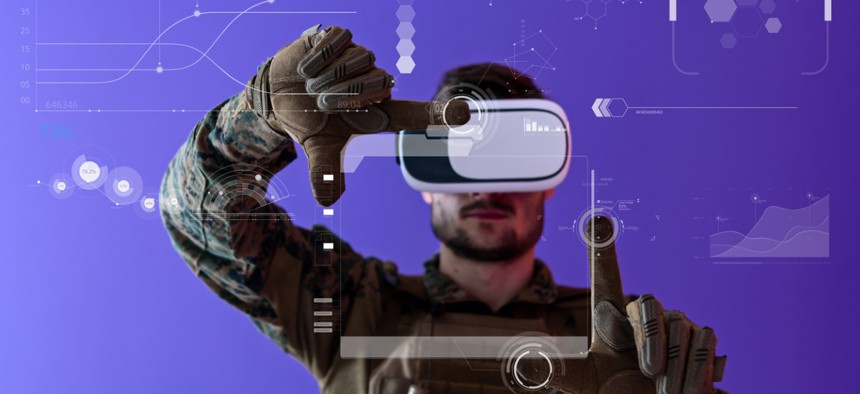Addressing the DOD ‘Disconnected Data’ Battlefield Challenge

.shock/iStock.com
Modern-day commanders do not suffer from an information vacuum.
One of the most oft-quoted statements during the Civil War was, “Get there first with the most men.”
Whether this battle cry was true then, it is not the case for military leaders today seeking asymmetric advantages on the modern battlefield. A more apt quote may be: “He who decides best, first wins.” Commanders cannot earn victories on speed and might alone; they win by making informed decisions based on access to real-time, accurate information. This is no easy feat; particularly for units operating at the farthest edges of the battlefield.
Modern-day commanders do not suffer from an information vacuum. The data is there, all around them, so much of it that the sheer volume slows rather than speeds up decision-making. There exists a lack of tools to parse all of this data at the edges of the battlefield, sort it, aggregate it and get it in the hands of commanders without having to wait as it cycles through command IT systems and data centers. The result? “Disconnected data” battlefields that often fall victim to a laborious flow of information between operation commanders and the Defense Department's upper echelons.
DOD leadership is acutely aware of the need to extend data capabilities to the forward edge of the fight. The U.S. Army, for example, has initiated tactical cloud pilots designed to extend soldiers’ command post applications to a distributed cloud environment. Longer term, the goal is to enable battlefield intelligence and data fusion in pioneering ways.
Extending the tactical cloud to the edge addresses the disconnected data challenge by unlocking several asymmetric advantages:
Real-time Data Analysis
In today’s conflicts, advantage comes from velocity. How quickly can data be transformed into actionable information? Real-time data analysis in disconnected and often harsh environments—even those at the farthest edge—requires deploying the cloud alongside the user. Doing so reduces the round-trip time of sending data back to a data center and enables decisions to be made right then and there.
Some might argue that we had the cloud in our pocket once the smartphone was commoditized. But there is a difference between having a device in your pocket that can access the cloud and having the cloud in your pocket. In the former, access to the cloud is dependent on connectivity—4G, satellite communications, MANET, etc. The latter is built on self-dependency and thriving even in the absence of connectivity.
Extending the analytical power of the cloud to the tactical edge allows for real-time data analysis, whether it is at the command post at-rest, mounted on military vehicles in-motion or on the soldiers themselves. For commanders, this means new and organic capabilities to inform maneuverability and situational awareness—even if the battlefield and those operating in it are disconnected from upper echelons.
Synthetic Virtualized Training Environments
Extracting applications from command data centers to the tactical edge can power highly realistic, synthetic virtualized training environments to improve soldier readiness and mission success. Digitized environments layered with topography, weather and other data-driven conditions while allowing for rapid-fire terrain changes allows troops to prepare as never before from training to battlefield.
Look no further than the recent U.S. Army announcement, covered by Nextgov, that Microsoft will build more than 120,000 HoloLens enabled augmented reality headsets. The news follows a 2018 contract Microsoft received to deliver the Army prototypes of the Integrated Visual Augmented System. The system taps augmented reality and machine learning to create a realistic “mixed reality” training environment so training rehearsals closely mirror what warfighters would experience in real-world engagements with adversaries.
Predictive Analytics with Sensor Data
The explosion of connected sensors and devices on vehicles, soldier wearables and unmanned drones has given rise to an Internet of Battlefield Things, or IoBT, that relies heavily on cloud computing at the tactical edge.
It is data collected from these “things” that can detect adversaries as convoys are on the move or flag issues with the health of troops or vehicles. The mission can be compromised if soldier health is at risk, and with immediate access, commanders can identify issues in time to take action.
Ultimately, tactical cloud capabilities translate to sensor data that can be processed and synthesized at the edge for real-time situational awareness - rather than waiting for analysis to take place at the command center and then be pushed back to decision-makers.
Transition to Dynamic Warfighting
Without cloud capabilities at the tactical edge, warfighters and leaders are restricted in how they can use data to quickly adapt to evolving training and battlefield conditions. Operating dynamically rather than in static environments can revolutionize soldier training, make it fully portable and tap into the brainpower of junior leaders—those in the thick of the fight—to adapt training in real-time.
At the same time, edge cloud and data capabilities create freedom for these leaders and warfighters to create their own tools and turn ideas into action, serving as a foundation for innovation and flexibility.
Col. (retired) Wade Johnston is director of innovation at Klas Government.



